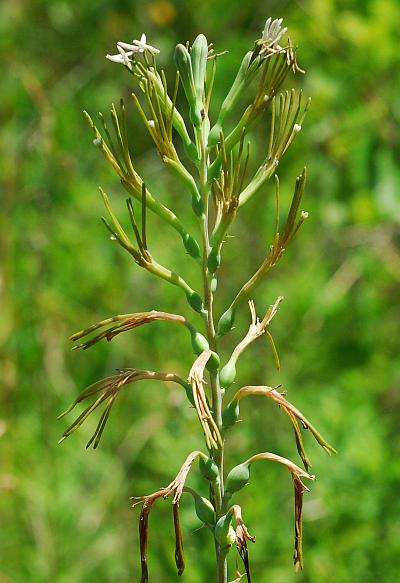Manfreda virginica (L.) Salisb. ex Rose
False Aloe

Native
CC = 7
CW = 5
MOC = 30
© SRTurner
Manfreda virginica (L.) Salisb. ex RoseFalse Aloe | |
 |
Native CC = 7 CW = 5 MOC = 30 |
© SRTurner |
|
Family - Agavaceae Habit - Perennial forb with a somewhat woody caudex. Stem - Vegetative stems reduced to a perennial caudex. Leaves - In basal rosette, 5-40 cm long, green or with reddish purple markings, somewhat fleshy and leathery, lanceolate to oblanceolate, parallel-veined, with spiny margins.
Inflorescence - Tall racemes or spikes 1 to 2.5 m long. Leafy bracts present, these reduced in size upward.
Flowers - Actinomorphic, perfect, tubular. Tepals 2-3 cm long, petaloid, in 2 whorls of 3, sometimes fused below, greenish yellow, the lobes brick red to brown, fused over half their length. Stamens 6, exserted, the anthers linear. Carpels 3, fused, the ovary inferior, the style elongate, the stigma 3-lobed.
Fruits - Globose capsules 1.0-1.5 cm long, with 3 or 6 locules. Seeds numerous, flattened, usually black.
Flowering - June - August. Habitat - Glades, open woodlands, usually in thin soils. Origin - Native to the U.S. Lookalikes - None. Other info. - This striking and unusual plant is common in the southeastern half of the state, rare or absent in the northwestern half. It North American distribution is restricted to the southeastern quadrant of the continental U.S. Photographs taken at Shaw Nature Reserve, Franklin County, MO, 7-20-2010, Washington State Park, Washington County, MO, 7-14-2017 and 10-16-2017, and at St. Joe State Park, St. Francois County, MO, 4-5-2024 and 7-11-2025 (SRTurner). |